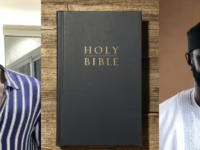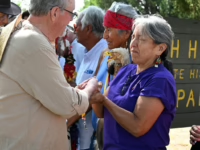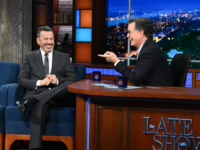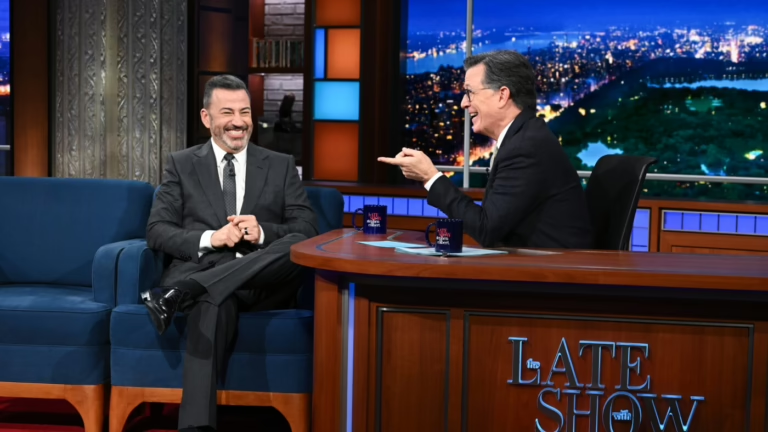Jimmy Kimmel appeared as a guest on The Late Show with Stephen Colbert on Tuesday, September 30, shortly after resuming his ABC late-night program.
Scott Kowalchyk/CBS
Jimmy Kimmel’s comeback to his ABC late-night show following a nearly week-long suspension was hailed by some as a victory for free expression against governmental overreach. Yet, from my perspective, it revealed something more profound.
Despite ongoing debates about the waning influence of late-night television, Kimmel’s return underscored that a significant audience remains deeply invested in the voices of hosts like him.
This sentiment was further reinforced during a collaborative week in Brooklyn, where Kimmel joined forces with fellow late-night personalities in New York.
From Kimmel’s candid moment on Stephen Colbert’s Late Show, where he confessed doubts about returning to air after Disney’s suspension, to the playful jab at President Trump shared by Kimmel, Colbert, and Seth Meyers on Jimmy Kimmel Live!, there was a palpable energy among these hosts. Their united front served as a reminder of the unique cultural space late-night television occupies.
Disney executives learned a tough lesson when they suspended Kimmel last month over his sharp critique of Trump supporters exploiting the assassination of conservative activist Charlie Kirk for political gain.
With the suspension following threats from the Federal Communications Commission’s chair toward Disney, ABC, and affiliates, it seemed Kimmel might become the next late-night host silenced for criticizing Trump, joining Stephen Colbert in that precarious position.
But then, a remarkable wave of resistance emerged.
During the show, Kimmel expressed gratitude to his audience for raising their voices so his could be heard, a collective effort that pressured Disney, Nexstar, and Sinclair to resume airing Jimmy Kimmel Live! – a turnaround that seemed improbable just days before.
This episode also serves as a vital reminder for late-night television itself, which has struggled to maintain relevance in recent years.
Perhaps, by defending Kimmel, the late-night format can rediscover its own path forward.
Revitalizing a once-iconic cultural institution
Amid reports of declining ratings, budget cuts, and financial setbacks, it’s easy to overlook the unique role late-night TV has historically played in American pop culture.
Today, however, the landscape has shifted. Podcasts and viral social media clips now deliver the kind of humor, commentary, and celebrity interviews that were once the exclusive domain of network late-night shows. These digital platforms have the advantage of reaching audiences wherever they are, especially as viewers migrate from traditional broadcast and cable to streaming services.
Historically, late-night television stayed vital by evolving to blend familiarity with innovation. Revisiting that legacy might offer valuable insights for how the genre can reinvent itself for modern audiences.
The origins: Late-night as the ultimate after-hours hangout
The journey begins with NBC’s The Tonight Show, which debuted in 1954 under the stewardship of Steve Allen – a multi-talented entertainer known for his wit and pioneering spirit.
Steve Allen in June 1956.
Associated Press
Like many early TV shows, Tonight Starring Steve Allen was still finding its footing, experimenting with the new medium. Watching the first episode today reveals Allen’s sharp, sardonic humor, reminiscent of the irreverence David Letterman would later popularize.
Despite its experimental nature, the show established many staples of late-night TV: a monologue, celebrity guests, a live band, and a studio audience, complemented by pre-recorded comedy sketches.
Filmed in Manhattan, Tonight bridged the gap between traditional variety shows like The Ed Sullivan Show and a hipper, more intimate format. It offered viewers nationwide a taste of the entertainment world’s glamour, as Broadway stars and sports legends dropped by, creating the feeling of an exclusive after-hours gathering.
The golden era: Late-night as the heart of mainstream entertainment
Following Allen’s departure, Tonight was refined by hosts Jack Paar and then Johnny Carson, who became known as the “King of Late Night.” Hailing from the Midwest, Carson’s calm, approachable style helped the show become a cultural juggernaut with a broad appeal.
Network television at the time aimed for the widest possible audience, avoiding divisive or complex topics. Carson’s gentle monologues, backed by a big band, and friendly celebrity chats became a nightly ritual for millions.
Steve Martin appeared on The Tonight Show Starring Johnny Carson in July 1980, humorously wearing fake jewelry to mock his own fame.
Lennox McLendon/Associated Press
For comedians, earning Carson’s approval-often symbolized by being invited to sit beside him after a strong stand-up set-was a career milestone. This endorsement helped launch the careers of stars like Bill Cosby, Drew Carey, Tim Allen, Roseanne Barr, Freddie Prinze, and David Letterman.
The evolution: Late-night as a hub for youthful, edgy comedy
In 1982, Carson negotiated ownership of the time slot following his show, enabling NBC to launch Late Night with David Letterman at 12:30 a.m. Letterman’s program featured a leaner band and a more irreverent tone, often lampooning the very institutions Carson had helped build.
Unlike Carson’s genial demeanor, Letterman was known for his confrontational style, famously clashing with celebrities like Cher, who once called him an “a**hole” on air. He also championed emerging comedians such as Bill Hicks and Jay Leno. (Letterman later faced criticism for refusing to air Hicks’ controversial set after moving to CBS.)
Letterman’s antics resonated with younger viewers and media enthusiasts, who appreciated his blend of absurdity and satire. Memorable moments included being submerged in a tank filled with Alka-Seltzer tablets and dropping watermelons from skyscrapers. His show also featured quirky recurring characters like Larry “Bud” Melman, played by Calvert DeForest, a former file clerk turned actor.
Comedian Richard Pryor appeared on Late Night with David Letterman in January 1987 while promoting the film Critical Condition.
Susan Ragan/Associated Press
Letterman’s approach gave voice to a generation skeptical of traditional show business, pushing the boundaries of late-night comedy. This youthful spirit continued with subsequent NBC Late Night hosts, from Conan O’Brien’s quirky humor to Jimmy Fallon’s energetic style.
When Carson retired in 1992, NBC controversially passed The Tonight Show to Leno, prompting Letterman to move to CBS and launch The Late Show from the Ed Sullivan Theater. Letterman also created The Late Late Show, where hosts like Craig Ferguson and James Corden experimented with the format in new ways.
An alternative path: Late-night as a platform for underrepresented voices
While many tried to challenge Carson’s dominance, Arsenio Hall found success by targeting audiences overlooked by mainstream late-night TV. Launching in 1989, The Arsenio Hall Show was syndicated nationwide and spotlighted Black culture and emerging artists who rarely appeared on other late-night stages.
With a funk and jazz fusion house band, the show featured groundbreaking guests like Prince, Bobby Brown, and MC Hammer before his breakout hit “U Can’t Touch This.”
Magic Johnson made his first public appearance on The Arsenio Hall Show after announcing his HIV diagnosis in November 1991.
Nick Ut/Associated Press
Today, the presence of hip-hop legends The Roots as the house band on Fallon’s The Tonight Show reflects the importance of inclusivity in late-night programming. By embracing diverse voices, networks can prevent new competitors from emerging to fill gaps left by traditional shows.
The current era: Political satire as a defining feature
Jon Stewart’s takeover of The Daily Show in 1999 marked a pivotal shift, focusing humor on real news and political events. This approach was as transformative as Saturday Night Live adopting weekly guest hosts or Carson launching Letterman’s career.
Stewart’s tenure produced a generation of influential comedians, including Stephen Colbert, Steve Carell, Samantha Bee, John Oliver, and Roy Wood Jr. His incisive critiques of media hypocrisy and political absurdity helped audiences navigate a complex news landscape.
On the other side, Fox News’ Gutfeld! offers a conservative late-night alternative, airing at 10 p.m. on cable and reaching a broad audience.
Political polarization has intensified, with hosts like Colbert, Kimmel, and Seth Meyers becoming outspoken critics of Trump’s administration. While their commentary can sometimes feel repetitive, the recent attempt to silence Kimmel has reinvigorated their satire.
Kimmel, often seen as an affable everyman, has been drawn into political discourse by Trump’s escalating extremism. His return show featured a memorable sketch with Robert De Niro portraying a mobster-style FCC commissioner, highlighting the power of celebrity satire in ways a lone podcaster cannot match.
Before this resurgence, I believed Conan O’Brien’s multi-platform success might point to late night’s future. Since ending his TBS show, O’Brien has thrived independently through podcasts, HBO Max specials, and social media content.
However, witnessing the renewed solidarity among Kimmel, The Daily Show, and Colbert amid threats from media conglomerates and political forces suggests another path forward.
The recent alliance of Kimmel, Colbert, Meyers, and Stewart-who even joined Kimmel’s monologue-demonstrates that late-night hosts can only endure by standing united.
Together, they can create viral moments that cut through media clutter and engage audiences where they are, a crucial strategy for late-night’s survival.
But they also need unwavering support from their employers, the media giants who control America’s most influential platforms, to protect their right to speak freely.
As someone who has attended tapings of Arsenio Hall, Colbert, Letterman, Meyers, Fallon, O’Brien, and Stewart, I firmly believe late-night television remains a vital pillar of American comedy. Its disappearance would be a significant cultural loss.
Ironically, the efforts by Trump officials and media executives to silence these voices may only deepen their appeal, attracting a new generation eager for bold, unfiltered commentary.






















